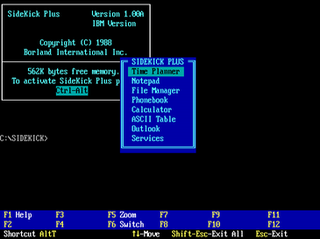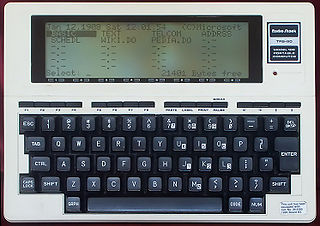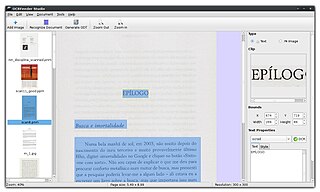This article has multiple issues. Please help improve it or discuss these issues on the talk page . (Learn how and when to remove these template messages)
|
Sprint is a text-based word processor for MS-DOS, first published by Borland in 1987.
This article has multiple issues. Please help improve it or discuss these issues on the talk page . (Learn how and when to remove these template messages)
|
Sprint is a text-based word processor for MS-DOS, first published by Borland in 1987.
This section contains content that is written like an advertisement .(August 2010) |
Sprint originally appeared as The FinalWord application, developed by Jason Linhart, Craig Finseth, Scott Layson Burson, Brian Hess, and Bill Spitzak at Mark of the Unicorn - a company (headquartered in Cambridge, MA) which is now better known for its music software products. At the time MOTU sold MINCE and SCRIBBLE, a text editor package based on Emacs. [1] [2] As The FinalWord, the package met with some success: for example, the manuals of the Lotus software package were written on it, as was Marvin Minsky's book The Society of Mind.
FinalWord II was renamed Sprint when it was acquired by Borland, which added a new user interface, new manuals, and features to the application. The editor speed was considered blazing at the time, running with no delays on machines as slow as 8 megahertz.
This was the time of European development for Borland: Sidekick and Turbo Pascal had been founded in Denmark; and the management of the European subsidiary comprised former Micropro France managers (Micropro was at the time the world leader in Word processing software with the famous WordStar line-up. They had success with the launch of WordStar 2000 - the first word processor package with a spelling dictionary in French.)
This is why the development and advertising of the product was carried out in France. Sprint is one of the very few major projects from an American software program publisher that had a French version shipped earlier than the American version.
Sprint v1.0 shipped in France with notable initial success, capturing a 30 percent market share and getting the jump on competing word processors. MicroPro was weakening with old Wordstar products and still-new WordStar 2000; WordPerfect was having problems with the translation and the user interface; and MS-Word was a decent but less polished or powerful product, and was also DOS and text-based.
The lack of beta-test mixed with pressure to ship for back-to-school time resulted in a Sprint 1.0 which had a range of minor glitches and bugs that had to be corrected with model 1.01 and a whole new set of diskettes for each registered user.
Version 1.0 (equivalent of French 1.01) shipped a few months later in the US and rest of world, with a mixed reception from customers. Traditional Borland fans who bought Sprint were happy with the editor, but wondered why the package included a sophisticated formatter, while business users who wanted a word processor just to write their memos and letters wondered what to do with the heavy manual and powerful features of the formatter language. In any event, word processing was shifting to WYSIWYG.
Version 1.5 did ship with a number of new features and real stability in France, but never made it elsewhere, although a number of localized versions had been built for various European countries. At this time, Borland Scandinavia had gone bankrupt, while Borland France had to be saved by massive financial help from the US. The developers who once worked in Europe had to move to the Scotts Valley CA premises. Version 1.5 was a reasonable success in France for some years, but Microsoft Word and Windows gained momentum and obscured all the other products.
In North America, Sprint never really gained traction in the marketplace, as it was overshadowed by WordPerfect and then Microsoft Word. It built up a small, but loyal and often enthusiastic, following among professional writers, researchers, academics, and programmers who appreciated its power, speed, and ability to handle large documents. Borland did not believe that there was enough of a market to warrant updating the product, and it eventually stopped supporting it.
Crash-recovery: Sprint had incremental back-up, with its swap file updated every 3 seconds, enabling full recovery from crashes. At trade shows, demos were made with one person pulling out the power cord, and the typist resuming work as soon as the machine restarted.
Spell-as-you-type: With this feature, Sprint could beep at you in real time when detecting a typo.
Multilingual editing: Sprint included dictionary switching, support for hyphenation, and spelling and thesaurus dictionaries that have yet to be matched by the competitors.
Separate formatter and programmable editor: These have been useful features for corporate environments aiming at standardizing documents or building "boilerplate" contracts. In France, for example, applications were built for Banques Populaires (loan contracts) or Conseil d'Etat, while some local government agencies created specific applications for tenders and contracts.
Powerful programming language: Programming in Sprint was done with the internal language of the word processor - a language that is much like C. Programmers have the ability to "get under the hood" and add modifications and extensions to an extent not possible with other word processors. Once written, Sprint programs are compiled into the interface, and run at full speed.
Interface switching: Modifications and extensions to Sprint can be saved into separate interfaces which can be easily and quickly switched. This is useful for people working in different languages, as the keys can be mapped to the accents and characters of each language, depending on the interface.
File handling: Users could work in up to 24 files at once. All open files could be saved on exit or not—and nevertheless automatically reopened as left, including each file's cursor position, cut and paste buffer contents, and spell check status. Because this behavior was accomplished using the crash-recovery swap file (see above), it allowed an "instant-on" behavior using the saved state from the previous run; this was unusual for its time.
Handling large documents: Sprint has the ability to publish large documents (hundreds of pages) with strict formatting consistency and automatic table of contents, index generation, tables of figures, and tables of authorities. These features made Sprint a leader in the production of technical documents - and Borland itself did all its manuals on Sprint, for years.
PostScript capabilities: Sprint could print in-line EPS images with dimensioning, and also had the ability to add in-line PostScript procedures. This made the product rather popular in the printing industry. For example, making a 200-page novel fit into 192 pages was simply a matter of changing the point size from 11 to 10.56. Sprint could size by 0.04 increment and scale the line spacing and kerning accordingly. (The 192 pages size is important in the printing industry, where the number of pages often has to be divisible by 32. A 200-page book would have to be printed using 224 pages, the extra 24 pages being empty.)
Consistency with familiar environments: The default editor key bindings were a subset of those provided by EMACS, and the mark-up language was a subset of Scribe, making it easy for people familiar with those tools to use Sprint.
BYTE in 1984 praised FinalWord 1.16's low memory requirements and many powerful features. Criticisms included great difficulty in learning how to use it and instability, including a serious bug that destroyed four days of work. [3] The magazine in 1989 listed Sprint as among the "Distinction" winners of the BYTE Awards, stating that "if you can live without [WYSIWYG], Sprint may be all you need in word processing software". [4]
MultiMate was a word processor developed by Multimate International for IBM PC MS-DOS computers in the early 1980s.

A text editor is a type of computer program that edits plain text. Such programs are sometimes known as "notepad" software. Text editors are provided with operating systems and software development packages, and can be used to change files such as configuration files, documentation files and programming language source code.

WordPerfect (WP) is a word processing application, now owned by Corel, with a long history on multiple personal computer platforms. At the height of its popularity in the 1980s and early 1990s, it was the dominant player in the word processor market, displacing the prior market leader WordStar.

WordStar is a word processor application for microcomputers. It was published by MicroPro International and originally written for the CP/M-80 operating system, and later written also for MS-DOS and other 16-bit PC OSes. Rob Barnaby was the sole author of the early versions of the program.
XyWrite is a word processor for MS-DOS and Windows modeled on the mainframe-based ATEX typesetting system. Popular with writers and editors for its speed and degree of customization, XyWrite was in its heyday the house word processor in many editorial offices, including the New York Times from 1989 to 1993. XyWrite was developed by David Erickson and marketed by XyQuest from 1982 through 1992, after which it was acquired by The Technology Group. The final version for MS-DOS was 4.18 (1993); for Windows, 4.13.
Turbo Pascal is a software development system that includes a compiler and an integrated development environment (IDE) for the Pascal programming language running on CP/M, CP/M-86, and DOS. It was originally developed by Anders Hejlsberg at Borland, and was notable for its extremely fast compilation. Turbo Pascal, and the later but similar Turbo C, made Borland a leader in PC-based development.
Lotus Symphony was an integrated software package for creating and editing text, spreadsheets, charts and other documents on the MS-DOS operating systems. It was released by Lotus Development as a follow-on to its popular spreadsheet program, Lotus 1-2-3, and was produced from 1984–1992. Lotus Jazz on the Apple Macintosh was a sibling product.

SPSS Statistics is a statistical software suite developed by IBM for data management, advanced analytics, multivariate analysis, business intelligence, and criminal investigation. Long produced by SPSS Inc., it was acquired by IBM in 2009. Versions of the software released since 2015 have the brand name IBM SPSS Statistics.
dBase was one of the first database management systems for microcomputers and the most successful in its day. The dBase system includes the core database engine, a query system, a forms engine, and a programming language that ties all of these components together. dBase's underlying file format, the .dbf file, is widely used in applications needing a simple format to store structured data.

AppleWorks was an integrated office suite containing a word processor, database, and spreadsheet. It was developed by Rupert Lissner for Apple Computer, originally for the Apple II platform and launched in 1984, and was later reworked for the Macintosh platform.

Borland Sidekick was a personal information manager (PIM) launched by American software company Borland in 1984 under Philippe Kahn's leadership. It was an early and popular terminate-and-stay-resident program (TSR) for MS-DOS which enabled computer users to activate the program using a hot key combination while working in other programs. Although a text-mode program, Sidekick's window-based interface echoed that of the Apple Macintosh and anticipated the eventual look of Microsoft Windows 2.0. It included a personal calendar, text editor, calculator, ASCII chart, address book, and phone dialer. According to the prospectus for Borland's initial public offering of stock to the public, Sidekick sold more than 1 million copies in its first three years.

PC-Write was a computer word processor and was one of the first three widely popular software products sold via the marketing method that became known as shareware. It was originally written by Bob Wallace in early 1983.

The TRS-80 Model 100 is a portable computer introduced in April 1983. It is one of the first notebook-style computers, featuring a keyboard and liquid crystal display, in a battery-powered package roughly the size and shape of a notepad or large book.
Sakura HyperMedia Desktop is an open source desktop environment and knowledge navigator for Unix. It is written in scripting languages such as Python and Tcl, and therefore runs on a variety of platforms. The Sakura HyperMedia Desktop Project lists the main features as follows:
Scribe is a markup language and word processing system that pioneered the use of descriptive markup. Scribe was revolutionary when it was proposed, because it involved for the first time a clean separation of presentation and content.

MicroPro International Corporation was an American software company founded in 1978 in San Rafael, California. They are best known as the publisher of WordStar, a popular early word processor for personal computers.
Nota Bene is an integrated software suite of applications, including word processing, reference management, and document text analysis software that is focused on writers and scholars in the Humanities, Social Sciences, and the Arts. The integrated suite is referred to as the Nota Bene Workstation. It runs on Microsoft Windows and Macintosh.

OCRFeeder is an optical character recognition suite for GNOME, which also supports virtually any command-line OCR engine, such as CuneiForm, GOCR, Ocrad and Tesseract. It converts paper documents to digital document files and can serve to make them accessible to visually impaired users.
Microsoft Office shared tools are software components that are included in all Microsoft Office products.

Haiku is a free and open-source operating system compatible with the now discontinued BeOS.
Manuals are on the "Wayback Machine", the Internet Archive in several formats, emobi, pdf, djvu, etc.
FROM https://archive.org/search.php?query=borland%20sprint
1. Borland Sprint Reference Guide 1988 (Jan 8, 2013) From the bitsavers.org collection, a scanned-in computer-related document. Topics: sprint, command, menu, text, file, commands, choose, formatter, chapter, format, reference guide,... Bitsavers
2. Borland Sprint Users Guide 1988 (Jan 8, 2013) texts From the bitsavers.org collection, a scanned-in computer-related document. Topics: sprint, file, text, choose, command, menu, files, typestyle, press, user, user interface, record... Bitsavers
3. Borland Sprint Advanced Users Guide 1988 (Jan 8, 2013) texts From the bitsavers.org collection, a scanned-in computer-related document. Topics: sprint, command, text, macro, format, file, commands, formatter, advanced, chapter, sprint... Bitsavers
4. Borland Sprint Alternative User Interfaces 1988 (Jan 8, 2013) texts From the bitsavers.org collection, a scanned-in computer-related document. Topics: sprint, user, menu, command, interface, wordstar, commands, msword, file, alternative, use Bitsavers